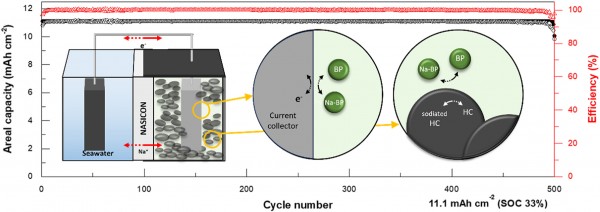Redox-targeting semi-liquid electrode with hard carbon for high-energy-density seawater batteries
- Journal
- Journal of Power Sources
- Year
- 2025
Seawater batteries (SWBs) emerge as the next generation of energy storage systems owing to their high potential energy densities. However, they suffer from low practical energy densities. Utilizing an open-structured cathode that leverages the unlimited supply of sodium ions from seawater, SWBs are inherently limited in energy density owing to the capacity of the anode. To maximize the amount of active material in a limited anode space, efforts with highly loaded electrodes present challenges in terms of sufficient reversibility, while liquid electrodes have low capacity, requiring alternative methods. To enhance the energy density of the SWB anode, this study employs the “redox targeting” method, which has been used to enhance the energy density in redox flow battery systems. Redox targeting is achieved by combining a hard carbon (HC) active material and a sodium biphenyl (Na-BP) redox mediator in a semi-liquid form. The proposed HC and Na-BP semi-liquid electrode (HCBP-SLE) demonstrates high areal energy density and stable performance. It achieves a capacity of 11.1 mAh cm−2 (=1 Ah) over 500 cycles (equivalent to 5000 h) in a SWB. Using this method, we achieve successful mass production of HCBP-SLE and its application in SWBs, demonstrating its potential for industrial utilization.

